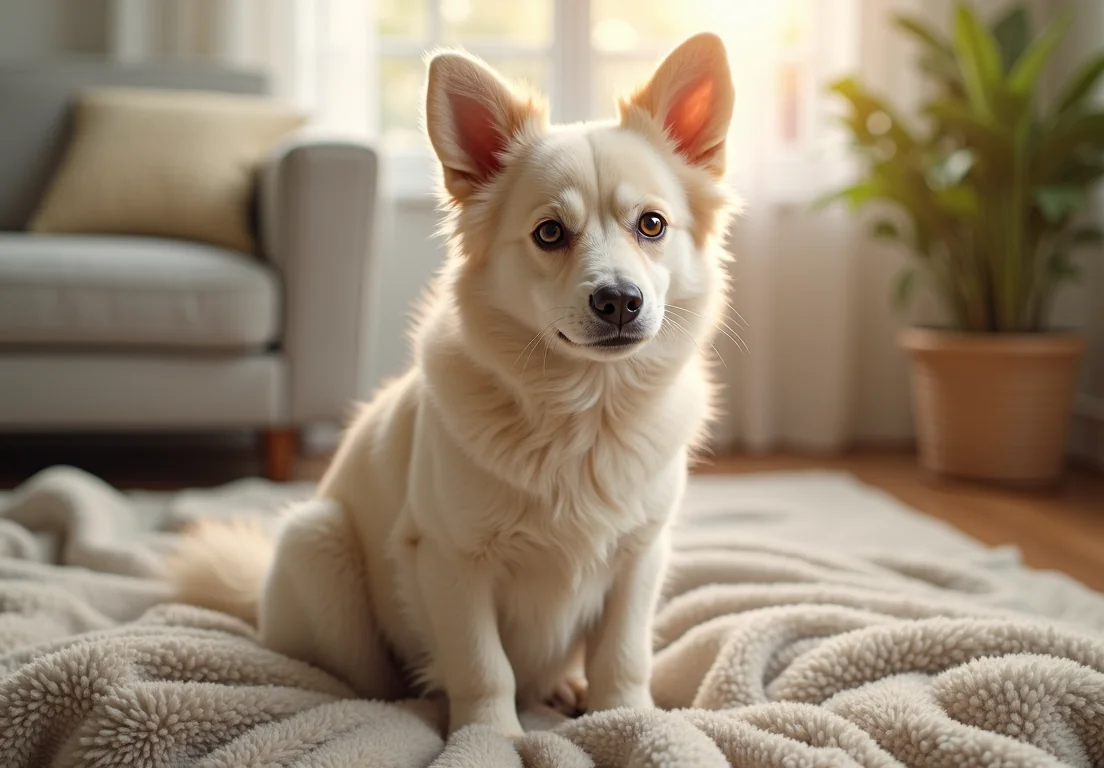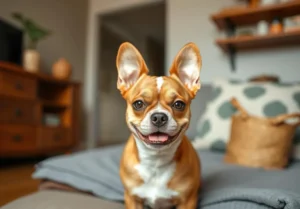Finding the right dog breed for apartment living can feel like searching for a needle in a haystack. You want a furry friend that fits your lifestyle, brings joy, and thrives in smaller spaces.
The best dog breeds for apartment living are typically small to medium-sized, have low to moderate energy levels, and are adaptable to confined spaces. Breeds like French Bulldogs, Cavalier King Charles Spaniels, and Dachshunds can make great companions for city dwellers. But there’s plenty more to consider when choosing the perfect pup for your cozy home, so keep reading to uncover the secrets of happy apartment life with a dog!

1. Size Matters for Apartment Living
Choosing a dog for your apartment isn’t just about love; size plays a significant role. Smaller breeds tend to adapt more easily to limited space, and they require less room to roam.
For instance, a Chihuahua or a French Bulldog can thrive in a studio or a one-bedroom, usually finding cozy spots like a sunny window ledge or snuggled up next to you on the couch.
But it’s not just about how much space they take up; it’s also about energy levels. Some small breeds have different needs, so consider those that are more laid-back and less prone to excessive barking or hyperactivity.
Cavalier King Charles Spaniels or Pugs are great examples, as they enjoy being with you rather than needing to dash around constantly.
Additionally, consider how certain small breeds handle stairs and elevators. Breeds like Bichon Frises or Toy Poodles are often comfortable navigating urban living challenges, but others may struggle. The right size dog can make all the difference in creating a peaceful coexistence in your modest apartment.
2. Temperament Traits to Prioritize
Finding a dog that fits seamlessly into your apartment life goes beyond size—it largely hinges on temperament. Dogs that can adapt well are typically gentle, social, and low-key. Look for traits like trainability, as a dog that responds well to commands can help you manage space better and maintain a calm environment.
Affectionate dogs can also make apartment living a joy. Breeds like Cocker Spaniels or Shih Tzus thrive on companionship and are perfect for cuddling after a long day. On the flip side, consider dogs that are less prone to separation anxiety, as you’ll want a breed that can handle being alone occasionally without becoming disruptive.
It’s also vital to think about how well dogs get along with others—both humans and pets. Sociable breeds like Maltese or Boston Terriers can make your apartment feel more like a home, easing transitions when guests come over or when you have to share space with fellow residents. A friendly dog often creates a community feeling, enhancing life in your compact surroundings.
3. Energy Levels and Exercise Needs
Finding the right balance between energy levels and the space you have can make or break apartment living with a dog. Higher-energy breeds need more vigorous exercise and mental stimulation, which can be challenging in smaller spaces.
Dogs like the Jack Russell Terrier or Border Collie are full of zest but might feel cooped up quickly without ample exercise. These breeds thrive in active environments and require daily runs plus playtime to stay content.
On the flip side, low-energy breeds are often ideal companions for apartment dwellers. Think of the French Bulldog or Basset Hound, who love lounging around just as much as they enjoy short walks. Understanding your dog’s individual needs and temperaments—some may be content with moderate strolls and playtime indoors—can help you create a harmonious living situation.
To understand how different dogs adapt to apartment living based on their individual needs, consider two hypothetical examples:
These examples demonstrate that understanding the specific needs of each breed can lead to a more harmonious living situation.
- A Jack Russell Terrier, known for its high energy, may require at least 60 minutes of exercise daily to stay content. If the owner can only provide 30 minutes of walking, the dog might exhibit signs of boredom or anxiety.
- In contrast, a French Bulldog might only need about 30 minutes of moderate exercise. If the owner provides daily short walks and indoor play, the dog is likely to remain calm and content in the apartment.
Consistency in schedule is key, too; short daily walks paired with interactive toys can work wonders for their well-being without requiring extensive space.
4. Best Breeds for Small Spaces
A handful of dog breeds shine when it comes to apartment living, offering charm and companionship without taking up too much room.
French Bulldog: These affectionate dogs are known for their low energy and minimal barking, making them perfect for close-knit living. Their small size allows them to comfortably thrive in tight spaces.
Cavalier King Charles Spaniel: These gentle lap dogs adore snuggling and don’t require extensive exercise, making them fantastic companions for those cozy apartment settings.
Pug: With their cheerful demeanor and compact build, pugs are adaptable to smaller spaces and only need moderate exercise—making them a great fit for an apartment lifestyle.
Dachshund: Known for their playful nature, these little guys are happy with short walks and play sessions. Their unique shape and smaller size make them adaptable to a variety of living situations.
Shih Tzu: As a mellow breed that enjoys lounging, Shih Tzus are well-suited for apartments, especially when their grooming needs are met.
Boston Terrier: These friendly dogs have short exercise needs and are content to play indoors, plus they’re typically quiet, which is a real bonus for apartment living.
Miniature Schnauzer: With their spirited personality and moderate exercise requirements, they enjoy a good romp as well as relaxed family time, fitting perfectly in small spaces.
Understanding the unique needs of these breeds is crucial. Each one brings its own personality to the mix, but they all thrive in confined spaces when given love, attention, and a little bit of daily exercise.
5. Noise Considerations
Choosing a dog for apartment living means keeping an ear on noise levels. Certain breeds, like Chihuahuas and Beagles, are notorious for their vocal tendencies.
Both Chihuahuas and Beagles have established reputations as vocal breeds. Chihuahuas are known for their strong territorial instincts, often barking at unfamiliar sounds or people, making them effective watchdogs. Their vocal nature can be particularly pronounced in apartment settings due to their small size and alert behavior. Beagles, originally bred for hunting, are also recognized for their barking tendencies. They commonly bark to alert their owners of potential threats or disturbances, reflecting their instinctual behavior as hunting dogs. Their distinctive howling, known as a “bay,” can be quite loud and carries over long distances, especially when they detect interesting scents or sights.
If your dog likes to bark at every passing squirrel, you might find your neighbors aren’t too pleased. It’s essential to consider breeds that tend to be quieter, such as French Bulldogs or Shih Tzus.
Additionally, investing time in training can help curtail excessive barking. Teaching your pup commands like “quiet” can save you from awkward encounters with the neighbors. Some breeds are naturally more adaptable to close living quarters. For instance, dogs like the Basenji are known as “barkless dogs”—a huge plus when you want to keep peace in your building.
To understand why the Basenji is considered a “barkless dog,” one can explore the breed’s characteristics. Basenjis have a unique vocalization that resembles a yodel rather than traditional barking. This is due to their tightly folded larynx, which alters their sound production. Therefore, if someone is looking for a quiet dog for an apartment, the Basenji is a fitting choice, as it typically does not engage in barking as other breeds do.
Just remember, regardless of the breed, regular socialization and stimulation are key to a well-behaved pup.
6. Socialization and Dog Parks
Socialization is a vital aspect of any dog’s life, especially for apartment dwellers that may not have as much outdoor space. Living in close quarters can affect how and when your dog interacts with others. Small dog breeds, such as Pugs or Cavalier King Charles Spaniels, usually thrive on social interactions.
Dog parks become essential spaces where your furry friend can mingle, run, and play. Although apartment living can limit your access to nature, planning regular visits to a dog park lets them burn off energy and meet new pals. Look for parks that have small dog areas to ensure safety during play sessions.
A unique angle to consider is the community aspect of dog ownership in apartments. Many buildings can have pet-friendly events or gatherings, providing an excellent opportunity for your dog to socialize while you connect with other pet owners. Engaging in these activities enhances the dog’s social experience and enriches your apartment living with a sense of community. Just ensure your chosen breed is comfortable with other dogs to make the most of these outings.
7. Apartment-Friendly Training Tips
Training a dog for apartment living requires a few tailored techniques to accommodate smaller spaces and limited outdoor time. Start with potty training; designate a specific spot outside for relief. Consistency is key—reward your dog immediately after they go in the right place. If there’s a litter box option, explore using pads or indoor grass, especially for smaller breeds or puppies.
To tackle potential separation anxiety, make your departures low-key. Practice leaving and coming back home for short periods, gradually increasing the duration. Offer engaging toys stuffed with treats to keep them occupied while you’re away. Consider crate training—dogs often feel secure in a snug space, which can help reduce anxiety.
Incorporating obedience commands during short training sessions can keep your dog mentally stimulated. Keep sessions brief—about 5 to 10 minutes—so your pup isn’t overwhelmed. These techniques not only strengthen your bond but also ensure a calm and pleasant living environment, even in tight quarters.
8. Dog-Friendly Amenities
A dog-friendly apartment is more than just allowing pets; it’s about creating a welcoming environment for both you and your furry friend. Look for features that enhance the experience for dogs and owners alike.
Nearby parks or dog runs are essential—having a safe space for exercise and socialization makes a big difference.
Proximity to pet-friendly cafés is a delightful perk, too.
Some apartments offer on-site pet facilities, like grooming stations or dog wash areas, which can be incredibly convenient.
Integrating pet waste stations around the complex encourages cleanliness and reduces stress for dog owners. Pet policies that include reasonable breed restrictions and weight limits can provide peace of mind. Moreover, Consider spaces with hardwood or tile flooring; they’re easier to clean in case of accidents compared to carpets.
Lastly, finding apartments with outdoor balconies can offer your dog some fresh air and a change of scenery without needing to leave home. Creating a cozy nook with comfortable bedding and greenery on the balcony can be a small yet significant perk for your pup.
9. Fun Facts About Apartment Dogs
Finding the right dog for apartment living can sometimes feel like an uphill battle, but there’s plenty of great news. Did you know some breeds actually thrive in smaller living spaces? Here are a few intriguing insights that might change how you view apartment pups:
-
Adaptability Is Key : Breeds like the French Bulldog and Cavalier King Charles Spaniel are known for their ease of adaptation. They don’t require tons of exercise to be happy; a nice walk or play session in the living room suffices.
-
Built for Comfort : Small breeds often come with a natural affinity for cozy spaces. Dogs like the Dachshund and Pug were historically bred to burrow and find shelter, making them perfectly content in smaller areas.
-
Barking Companions : Contrary to common belief, many apartment-friendly dogs are surprisingly quiet. Breeds such as the Shih Tzu and Bichon Frise aren’t known for being overzealous barkers, which makes them ideal for living close to neighbors.
-
Less Space, More Play : Smaller breeds often have explosive energy in short bursts. Dogs like the Miniature Pinscher can get a good workout indoors, needing less space to get those zoomies out!
-
Easier Management : Many small dogs require less grooming, which can make daily upkeep easier in a busy apartment life. For instance, Chihuahuas need minimal brushing compared to larger breeds, keeping your space tidy.
-
Social Butterflies : Apartment life tends to foster a close-knit community, and breeds like the Beagle are naturally social animals. They thrive around people and encourage interactions with your neighbors.
-
Saving Space : Dog beds and toys can take up tons of room, but many breeds can fit perfectly in small corners or cozy spots. The compact size of breeds like the Toy Poodle makes them a breeze to accommodate, both for you and your dog.
-
Mind Over Matter : Some might think larger dogs can’t adapt to tight quarters, but breeds like the Greyhound are actually quite chilled out. Known as “couch potatoes,” they can unwind comfortably in smaller homes after their daily exercise.
With these fun facts in mind, you can see how some dog breeds aren’t just suitable for apartments—they truly flourish in them!
Alex, a passionate animal lover, has experience in training and understanding animal behavior. As a proud pet parent to two dogs and three cats, he founded AnimalReport.net to share insights from animal experts and expand his knowledge of the animal kingdom.





